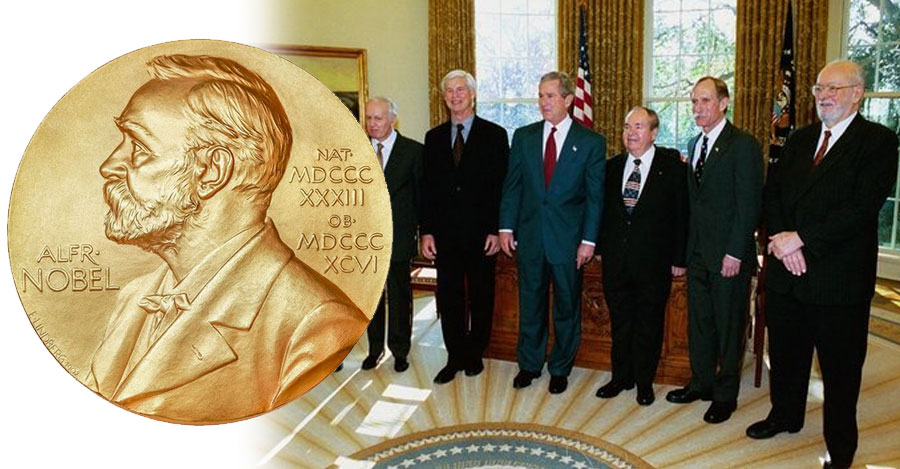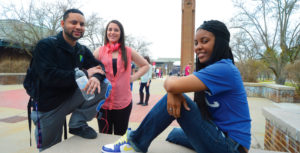
Since 1901, the Nobel Prize has existed to acknowledge superior contributions to physics, chemistry, medicine, economics, literature, and the cause of peace. This week, the 2018 Nobel Prize announcements are taking place to give us the next set of difference makers in these academic and social fields. Their efforts will most likely be felt for years to come.
Did you know that a number of prominent SUNY faculty members have been recipients of this esteemed award through its history? Our SUNY colleges and universities have produced fifteen Nobel award winners whose efforts have had great impact in the fields of science, medicine, and social issues. Below, we have short biographies and information about their notable achievements, the impact of those achievements, and their influence on their particular campuses. Read on to learn more of SUNY’s international impact.
C.N. Yang, Stony Brook University
1957 Nobel Prize in Physics
Considered to be as basic a contribution to science as Einstein’s Theory of Relativity, the Yang-Mills theory brainstormed by C.N. Yang transformed the understanding of how subatomic particles interact, an idea that became a major influence on modern physics and mathematics. The breakthrough demonstrated that standard theories about parity conservation are violated at the subatomic level, in the process of nuclear decay that emits alpha or beta particles. Yang was awarded the Nobel Prize in Physics in 1957 in recognition of his work in statistical mechanics and symmetry principles. Yang was appointed Albert Einstein Professor Emeritus of Physics at Stony Brook University, where he became the first director of the newly-founded Institute for Theoretical Physics. His formative years took place during the infancy of particle physics, and he employed an inductive method of inquiry that he learned from Enrico Fermi and Edward Teller. Though Yang did the majority of his Nobel work at the Institute for Advanced Study in Princeton, New Jersey, he led the Institute for Theoretical Physics—which celebrated its fiftieth anniversary in 2017—through a fertile period of scientific achievement, especially the discovery of supergravity in 1976. Yang retired in 1999.
Sir John Carew Eccles, University at Buffalo
1963 Nobel Prize in Medicine
Developing a childhood interest in the intricacies of the human brain into a prestigious career as a researcher, teacher and author that spanned more than half a century, Sir John Carew Eccles was a pioneer in the study of higher brain functions. The University at Buffalo professor shared the 1963 Nobel Prize in Medicine with Alan Hodgkin and Andrew Huxley for his discovery of the chemical means of impulse communication across synapses, the junctions between nerve cells. His work essentially proved how, by physics and chemistry, messages are passed from one nerve cell to another, and his conclusions were seen as a key to understanding higher functions of the brain. “Brain research is the ultimate problem confronting man…To the extent that we have a better understanding of the brain, we will have a richer appreciation of ourselves, our fellow men, and of society, and in fact, of the whole world and its problems,” said Eccles, who has always been concerned with the biophysical properties of synaptic transmission. Beginning his work at the Australian National University, Eccles moved on to the Institute of Biomedical Research at Chicago, and in 1968 came to the University at Buffalo, where he became professor of physiology and medicine and directed a neurobiology research unit until he retired. While at UB, he published The Understanding of the Brain (1973). Eccles was named SUNY Distinguished Professor in 1975. He died in Switzerland in 1997.
Herbert A. Hauptman, University at Buffalo
1985 Nobel Prize in Chemistry
While conducting experiments, Herbert A. Hauptman pioneered using mathematics to determine the atomic structure of complex molecules, transforming the field of chemistry and inspiring a new era of research. Today, these direct methods, which he never ceased refining, are still widely used to solve complicated structures. Though the concepts were first met with skepticism, they led to his solution for the phase problem in X-ray crystallography while working with the crystallographic group of the Medical Foundation of the University at Buffalo. He was awarded the Nobel Prize in Chemistry along with Jerome Karle in 1985. The advances in X-ray crystallography that Hauptman’s work inspired continue to have a huge impact on the design of therapeutic drugs to prevent and treat life-threatening diseases. He became research director and later president of the Medical Foundation of Buffalo in 1972, which in 1994 was renamed the Hauptman-Woodward Medical Research Institute, where he continued to work daily into his nineties, passing in 2011. The Institute continues to do cutting-edge research, from identifying new classes of anti-tumor agents to finding new ways to fight opportunistic infections in AIDS patients.
Ronald Coase, University at Buffalo
1991 Nobel Prize in Economics
In “The Nature of the Firm” (1937) – his famous essay – Ronald Coase explained why the economy consists of a number of firms instead of a multitude of self-employed contractors: transaction costs, which drive up the price of products. This economic theory, thought at first controversial because of its counterintuitive challenge to Adam Smith’s philosophy, has proved enduring and influential, inspiring entirely new fields of scholarship. After arriving from the London School of Economics, Coase served as a professor in the University at Buffalo’s economics department for eight years. He was awarded the Nobel Prize in Economics in 1991 for his work in describing the impact of transaction costs and property rights on the makeup and functioning of the economy. The majority of his prizewinning work was done at Buffalo.
Toni Morrison, Purchase College and University at Albany
1993 Nobel Prize in Literature
Novelist, essayist, playwright, librettist — Toni Morrison’s work spans page, stage and screen. Her unique narrative technique has earned wide acclaim and prestigious awards including the National Humanities Medal (2000), the Presidential Medal of Freedom (2012) and the PEN/Saul Bellow Award for Achievement in American Fiction (2016). Morrison is the first African American woman to receive the Nobel Prize, which recognized her in 1993 as someone “who in novels characterized by visionary force and poetic import, gives life to an essential aspect of American reality.” Her extensive resume also includes teacher. Morrison was a Visiting Lecturer in Literature at Purchase College from 1971-1972. In 1983, the State University of New York, through the college’s School of Humanities, awarded her with an honorary doctorate of humane letters degree. During her tenure as Schweitzer Chair in the Humanities at the University at Albany in the 1980s, Morrison taught classes in the Department of English; wrote the novel Beloved, which won the Pulitzer Prize for Fiction in 1988; completed the writing and oversaw the production of her first play, Dreaming Emmett; and sponsored five Schweitzer Humanities Fellows scholars and writers.
Robert F. Furchgott, Downstate Medical Center
1998 Nobel Prize in Medicine
The first Nobel Laureate within the State University of New York to have conducted his research on a SUNY campus, Robert F. Furchgott’s discovery of the role that nitric oxide (NO) plays in the contraction and dilation of blood vessels inspired a revolution in the scientific comprehension of vascular physiology, and won him the Nobel Prize in Medicine in 1998. Furchgott observed that the endothelium, a single layer of cells on the innermost surface of blood vessels, produces a diffusible substance that causes the underlying smooth muscle to relax. The substance was nitric oxide (NO). His discovery inspired an explosion in NO research and helped scientists understand and find new treatments for cardiovascular diseases and a host of other conditions ranging from immune disorders to memory loss. In honor of his work, Dr. Alfred Stracher of Downstate Medical Center suggested the establishment of the Robert F. Furchgott Society in 2005. The Society supports graduate students, fellows and residents conducting basic science and clinical studies in a broad array of subjects. Each year one exceptionally talented graduating Ph.D. student and one medical student is honored with The Robert F. Furchgott Award for Excellence in Research.
J.M. Coetzee, University at Buffalo
2003 Nobel Prize in Literature
In a letter to his friend and fellow novelist Paul Auster, J. M. Coetzee made a remark that concisely describes his work: “I must say that I get impatient with fiction that doesn’t try something that hasn’t been tried before, preferably with the medium itself.” He was awarded the Nobel Prize in Literature in 2003. He was a faculty member in the Department of English at the University at Buffalo from 1968-71 when he began his first novel, Dusklands. Hailed as one of the most original contemporary novelists, Coetzee dramatizes the effects of racism, oppression, and fear in apartheid-era South Africa. His narrative devices include allegory, unreliable narrators, and symbolic settings. Other work includes In the Heart of the Country (1977), Waiting for the Barbarians (1980) and the Booker Prize winner Life & Times of Michael K (1983). From as early as 1968 he sought permanent residence in the United States, a process that was finally unsuccessful, in part due to his involvement in anti-Vietnam-War protests. He did return as Butler Professor at UB in 1984 and 1986. As a capper to his career, his recent release Late Essays: 2006-2017 collects most of the literary criticism Coetzee has written during the last 11 years.
Paul C. Lauterbur, Stony Brook University
2003 Nobel Prize in Medicine
While working as a professor of chemistry and radiology at Stony Brook University in 1971, Paul C. Lauterbur became interested in the possible biological applications of nuclear magnetic resonance (NMR) after reading a paper by Raymond V. Damadian, a physician at SUNY Downstate, who described how some cancerous tissues respond differently to magnetic fields than normal tissue. Lauterbur took the idea to the next step by conceiving a way to focus NMR signals so they revealed the specific locations of physical abnormalities. By creating gradients in the strength of the magnetic field, 2D and 3D images could be created, enabling a visual map of problem spots in the body. It was a novel idea and led to what is now known as magnetic resonance imaging (MRI), for which Lauterbur shared the Nobel Prize in Medicine in 2003. The invention is one of the greatest scientific innovations of the 21st century, and benefits millions of people each year. The instrument on which Lauterbur performed his critical experiments—a Varian A-60 NMR spectrometer—is on permanent display in the lobby of the Graduate Chemistry building at Stony Brook.
Robert Aumann, Stony Brook University
2005 Nobel Prize in Economics
A branch of applied mathematics, Game Theory seeks to explain conflict and cooperation between countries, businesses or people through the use of mathematical models. Robert Aumann, who spent 17 years as a part-time faculty member at Stony Brook University, where he helped found the Center for Game Theory, won the 2005 Nobel Prize in Economics his work in game theory. His signature contribution was in the realm of repeated games, which are situations in which players encounter the same situation over and over again. “He’s Mr. Game Theory,” said Stony Brook economics Prof. Yair Tauman. “He’s been in this field since 1953 and has made huge contributions to game theory. I think it was overdue for a long time.” Aumann now teaches at the Hebrew University in Jerusalem and returns each July to Stony Brook for a 10-day game theory conference attended by 1,500 economists from all over the world. By applying game theory to the study of war, Aumann has found that appeasement can actually cause war, while credible threats can reliably prevent it.
Marvin Geller, Robert Cess, Minghua Zhang and Edmund Chang, Stony Brook University
2007 Nobel Peace Prize
The Nobel Peace Prize 2007 was awarded jointly to Intergovernmental Panel on Climate Change (IPCC) and Albert Arnold (Al) Gore Jr. “For their efforts to build up and disseminate greater knowledge about man-made climate change, and to lay the foundations for the measures that are needed to counteract such change.” Four faculty members at Stony Brook University’s School of Marine and Atmospheric Sciences were acknowledged for their contributions to the IPCC.
Marvin Geller, a stratospheric expert and thirty-year veteran of international collaborations, was a key influence in crafting the 1987 United Nations Montreal Protocol to address the issue of ozone depletion. Broad compliance with the Protocol along with industry’s creating of ozone-friendly substitutes for the now-controlled chemicals, has stabilized the ozone layer.
A recognized leader in the fields of climate change and atmospheric radiation transfer, Robert Cess found that since they have optical properties that change with their composition, clouds can reduce or increase global warming. This work was a critical element in the first IPCC Assessment Report that was published in 1990.
Minghua Zhang discovered two types of climate feedback processes: those that would speed climate change such as water vapor and those that would slow climate change, such as increased cooling in the upper troposphere, enabling the loss of system energy. This analysis was an essential element in the 1997 Kyoto Protocol, which set benchmarks for reducing emissions.
Thanks to improved climate computer models, Edmund Chang was able to effectively assess how midlatitude storms morph under global warming, which aids greatly in catastrophe prediction of events like superstorms. Chang made major contributions to the fourth IPCC Assessment Report.
Chang Kee Yung, Stony Brook University
2014 Nobel Prize in Physics
Since arriving at Stony Brook in 1990, Chang Kee Yung has been in the vanguard of recognizing the important role that neutrino physics would play in the subsequent decades. A SUNY Distinguished Professor in Physics, Yung started a research group called Nucleon Decay and Neutrino (NN) to study neutrino properties and search for proton decays. The NN group contributed significantly to the collaborations that made an historic discovery of the neutrino oscillation phenomenon, resulting in a Nobel Prize in Physics in 2014. The ground breaking experiments, which demonstrated that neutrinos change identities, entailed shooting high-energy pulses of particles from an accelerator on Japan’s east coast to a detector 185 miles away on the west coast. The findings could prove critical to understanding the role of antimatter in the origin of the cosmos. Yung has shifted his research effort to the Deep Underground Neutrino Experiment (DUNE), which is expected to discover charge-parity symmetry violation in the lepton sector, an important clue for scientists to understand the matter-antimatter asymmetry in the universe along with proton decay and neutrinos from supernova explosions.
Joachim Frank, University at Albany
2017 Nobel Prize in Chemistry
SUNY Distinguished Professor Joachim Frank, along with Jacques Dubochet of Switzerland and Richard Henderson of the United Kingdom, was awarded 2017 Nobel Prize in Chemistry for developing cryo-electron microscopy. The method, which radically improves the imaging of biomolecules, has initiated a new era in biochemistry. Thanks to their discoveries, electron microscopes now enable researchers to see molecules in high resolution, revealing everything from proteins that provoke antibiotic resistance to the surface of the Zika virus. This furthers the understanding of their operation and aids in the design of pharmaceuticals to combat them. From 1975 – 2008, Frank was a senior research scientist and lab chief with the Wadsworth Center, a partner of UAlbany’s School of Public Health. During his time with Wadsworth and UAlbany, Frank became an investigator at the Howard Hughes Medical Institute and, in 2006, was elected to the National Academy of Sciences and the American Academy of Arts & Sciences. He was named a SUNY Distinguished Professor in 2007. Currently a professor in the Department of Biological Sciences at Columbia University, Frank maintains an affiliation with The RNA Institute at UAlbany on research related to structural biology.
These distinguished Nobel laureates serve as proof of the solid educational foundation at SUNY, past and present. Currently many are doing advanced work in the young fields of nanotechnology and biotechnology, and from this group more discoveries—and awards—may yet emerge. These are the minds that are educating the next generation of scientists, artists and scholars, while working to improve the world.



